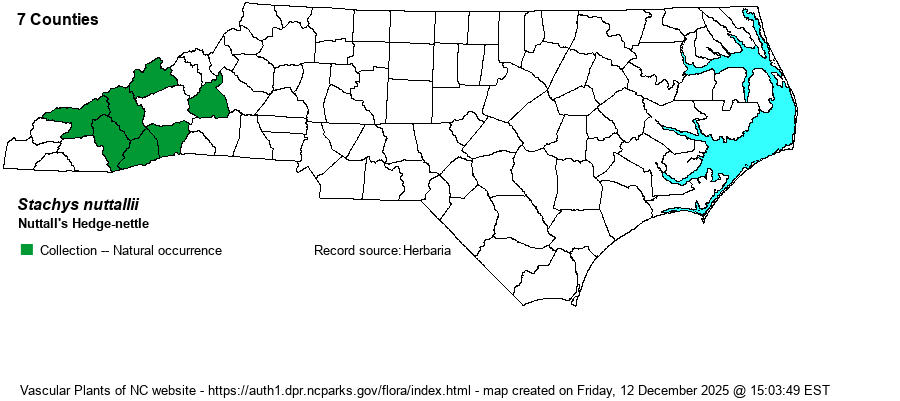| Author | Shuttleworth ex Bentham | |
| Distribution | Present only in the southern half of the Mountains, north only to Madison County; possibly absent in the far southwestern counties. Easily confused with S. cordata, and some specimens of these two might be misidentified.
This is a species ranging from KY south to northern GA and central AL. It has not been found in VA, according to the Digital Atlas of the Virginia Flora. | |
| Abundance | Apparently rare to uncommon. The NCNHP oddly calls it S1? for the State Rank, but then fails to list it as Significantly Rare or even Watch List, which is conflicting information. It does not appear to be overly scarce in its range in NC, but the website editors feel that it should be considered as a Watch List species, with a State Rank of S2? | |
| Habitat | This species is found in rich to damp areas, often in wet forests, bottomlands, and mesic to rich slopes, often over circumneutral soil. Habitat differences between this species and the similar S. cordata are not very clear and distinct; that species also occurs in lower elevations in rich or moist shaded soil. The similar S. clingmanii occurs at high elevations. |
| Phenology | Blooms from June to August, and fruits for September to October. | |
| Identification | This species has distinct petioles, but they are somewhat short, usually less than 1/5-inch long; the similar S. cordata and S. clingmannii have longer petioles, of 2/5-inch long or more. It and S. cordata are among the few in the genus with cordate to truncate leaf bases, with the paired leaves being ovate in overall shape. However, this species has the leaves more narrowly ovate to oblong, with a more truncate leaf base or even slightly tapered, and seldom really cordate, as seen in S. cordata. The leaf margins are clearly crenate or shallowly serrated (with rounded teeth), as opposed to more strongly serrated or dentate (sharp teeth) margins in S. clingmanii. This species has the inflorescence of whorled flowers somewhat lax and may have a drooping tip, as does S. cordata; as opposed to a stiff and thus quite erect inflorescence in S. clingmanii. Lastly, in this species, the bracts within the inflorescence of this species and S. cordata are very small, making the inflorescence somewhat naked (devoid of bracts), whereas in S. clingmanii the bracts are gradually reduced in size and thus there are some small "bract-like" leaves in the inflorescence. As mentioned above, there is an elevation difference between S. clingmannii and both S. nuttallii and S. cordata, with these latter two being the lower elevation ones. Check the species account of S. cordata for more details on separation of that species from S. nuttallii. | |
| Taxonomic Comments | Some references include this species and S. cordata into the same species. Things are actually more confusing than this, and are beyond the scope of this website. But, the species S. clingmannii, S. cordata, S. nuttallii, the former S. riddellii, and probably also S. latidens have all been confused in the literature.
Stachys is a large and complex genus that is still actively being worked on, and our understanding of the species is slowly being clarified. For interested readers, we recommend journal papers by Nelson (1981, 2008) and by Fleming et al. (2011). | |
| Other Common Name(s) | None? | |
| State Rank | S1? [S2?] | |
| Global Rank | G5? | |
| State Status | [W7] | |
| US Status | | |
| USACE-agcp | | |
| USACE-emp | | |

